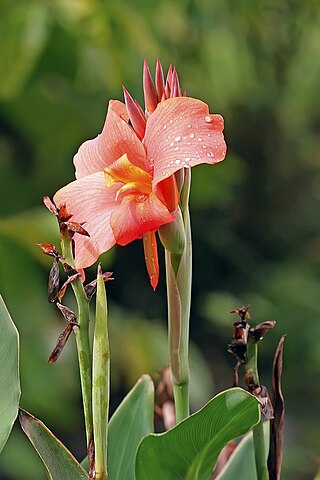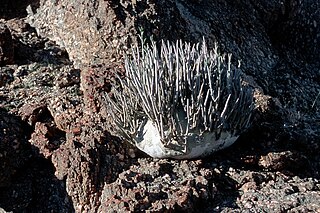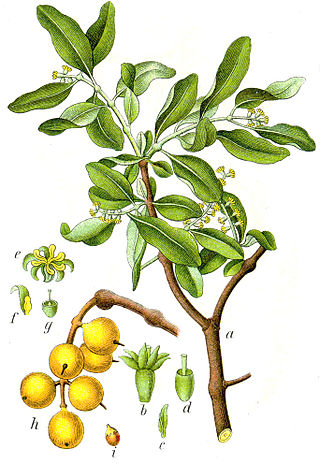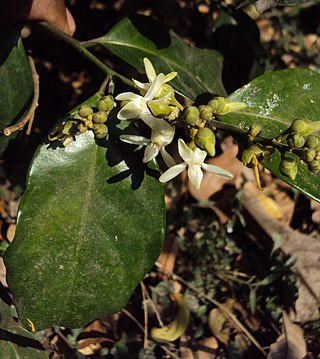
Meliaceae, the mahogany family, is a flowering plant family of mostly trees and shrubs in the order Sapindales.

Canna or canna lily is the only genus of flowering plants in the family Cannaceae, consisting of 10 species. All of the genus's species are native to the American tropics and naturalized in Europe, India and Africa in the 1860s. Although they grow native to the tropics, most cultivars have been developed in temperate climates and are easy to grow in most countries of the world, as long as they receive at least 6–8 hours average sunlight during the summer, and are moved to a warm location for the winter. See the Canna cultivar gallery for photographs of Canna cultivars.

Morus, a genus of flowering plants in the family Moraceae, consists of diverse species of deciduous trees commonly known as mulberries, growing wild and under cultivation in many temperate world regions. Generally, the genus has 64 subordinate taxa, three of which are well-known and are ostensibly named for the fruit color of the best-known cultivar: white, red, and black mulberry, with numerous cultivars and some taxa currently unchecked and awaiting taxonomic scrutiny. M. alba is native to South Asia, but is widely distributed across Europe, Southern Africa, South America, and North America. M. alba is also the species most preferred by the silkworm, and is regarded as an invasive species in Brazil and the United States.

Lagerstroemia, commonly known as crape myrtle, is a genus of around 50 species of deciduous and evergreen trees and shrubs native to the Indian subcontinent, southeast Asia, northern Australia, and other parts of Oceania, cultivated in warmer climates around the world. It is a member of the family Lythraceae, which is also known as the loosestrife family. The genus is named after Swedish merchant Magnus von Lagerström, a director of the Swedish East India Company, who supplied Carl Linnaeus with plants he collected. These flowering trees are beautifully colored and are often planted both privately and commercially as ornamentals.

Saraca asoca, commonly known as the Ashoka tree, is a plant belonging to the Detarioideae subfamily of the legume family. It is an important tree in the cultural traditions of the Indian subcontinent and adjacent areas. It is sometimes incorrectly known as Saraca indica. The flower of Ashoka tree is the state flower of Indian state of Odisha.

Aleurites is a small genus of arborescent flowering plants in the Euphorbiaceae, first described as a genus in 1776. It is native to China, the Indian Subcontinent, Southeast Asia, Papuasia, and Queensland. It is also reportedly naturalized on various islands as well as scattered locations in Africa, South America, and Florida.

Azadirachta is a genus of two species of trees in the mahogany family Meliaceae. Numerous species have been proposed for the genus but only two are currently recognized, Azadirachta excelsa and the economically important tree Azadirachta indica, the neem tree, from which neem oil is extracted. Both species are native to the Indomalaysian region, and A. indica is also widely cultivated and naturalized outside its native range.

Adenia is a genus of flowering plants in the passionflower family Passifloraceae. It is distributed in the Old World tropics and subtropics. The centers of diversity are in Madagascar, eastern and western tropical Africa, and Southeast Asia. The genus name Adenia comes from "aden", reported as the Arabic name for the plant by Peter Forsskål, the author of the genus.

Myristica is a genus of trees in the family Myristicaceae. There are over 150 species, distributed in Asia and the western Pacific.
Shirakiopsis is a genus of flowering plants in the family Euphorbiaceae first described as a genus in 1999. There are six known species, 3 native to tropical Asia and 3 to tropical Africa.

Loranthus is a genus of parasitic plants that grow on the branches of woody trees. It belongs to the family Loranthaceae, the showy mistletoe family. In most earlier systematic treatments it contains all mistletoe species with bisexual flowers, though some species have reversed to unisexual flowers. Other treatments restrict the genus to a few species. The systematic situation of Loranthus is not entirely clear.

Horsfieldia is a genus of evergreen trees. The genus consists of about 100 species and is distributed across South Asia, from India to the Philippines and Papua New Guinea. Some species are used for timber. Species in the genus sometimes contain alkaloids, including horsfiline, which has analgesic effects.

Knema is a genus of plant in family Myristicaceae, mostly consisting of small-medium trees found in lowland tropical forests from south and northeast of India, Indochina, Malay Archipelago to near the tip of New Guinea. The highest diversity of species is in Borneo in west of Malesia.

Xanthophyllum is a genus of about 109 species of trees and shrubs, of the plant family Polygalaceae;. The generic name is from the Greek meaning "yellow leaf", referring to how the leaves are often yellow when dry. In Borneo it is known as minyak berok in Malay or nyalin in the Iban language.

Saraca indica, commonly known as the asoka tree, ashok or simply asoca, is a plant belonging to the subfamily Detarioideae of the family Fabaceae. The original plant specimen from which Carl Linnaeus described the species came from Java, but the name S. indica has been generally incorrectly applied to S. asoca since 1869. It can be distinguished from S. asoca by its non-clasping bracteoles, a lower number of ovules, slightly smaller pods, and a more eastern geographic distribution.

Saraca thaipingensis is a tree species native to southeast Asia in the family Fabaceae. It has yellow flowers, borne on old wood, and is grown as an ornamental for floral effect. Common names include yellow ashoka and yellow saraca.

Rhododendron section Tsutsusi was a subgenus of the genus Rhododendron, commonly referred to as the evergreen azaleas. In 2005 it was reduced to a section of subgenus Azaleastrum. Containing 80 - 117 species, it includes both deciduous and evergreen types and is distributed in Japan, China and northeastern Asia. They are of high cultural importance to the Japanese. Among the species in this genus lie the largest flowering azaleas.

Zanthoxylum armatum, also called winged prickly ash or rattan pepper in English, is a species of plant in the family Rutaceae. It is an aromatic, deciduous, spiny shrub growing to 3.5 metres (11 ft) in height, endemic from Pakistan across to Southeast Asia and up to Korea and Japan. It is one of the sources of the spice Sichuan pepper, and also used in folk medicine, essential oil production and as an ornamental garden plant.
Saraca griffithiana is a tree native to Yunnan Province of China and also to Burma (Myanmar). It is a forest tree sometimes attaining a height of 18 m. It can be distinguished from the related Saraca divesPierre by its short bracts less than 5 mm long, and by its articulate petioles.

Bhesa indica is a flowering plant tree species in the Centroplacaceae family. It is distributed along the tropical wet evergreen forests of the Western Ghats of India. It is considered synonymous with Bhesa paniculata by some authors.

















